After going to bed before 8PM on Sunday, DH and I both woke up exceedingly early on Monday. I know he was up around 4, and I woke up around 5. We did both manage to go back to sleep until Luke got up at 6:30. The high for the day was only 62F/16.6C, lower than the *low* back home! I think the current temp when we left the hotel was only about 50F/10C. We hadn't seen temps that low since April. It was almost more than our poor thin Southern blood could take in mid-June! There was a misty rain in the air, but the chance of actual storms was low, so we headed out for our "urban hike," Boston's Freedom Trail.
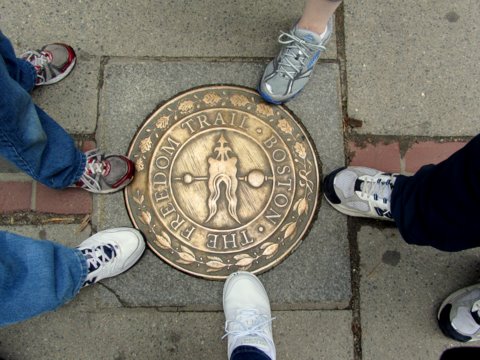
And where better to start the Freedom Trail than at the official beginning, the Visitor's Center at Boston Common.
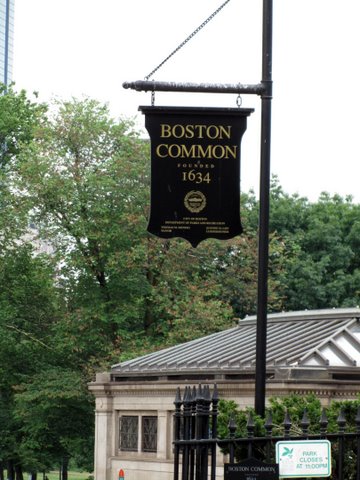
We hopped the T to Park Station. As we stepped out of the station, a man approached us. I was prepared for a panhandler (though he was awfully well dressed), but he was wearing an embroidered polo shirt and a name tag that identified him as a "downtown tour guide," or something similarly official. He offered us a Freedom Trail map and pointed the way to the visitor center. How very nice, thank you! We walked down the hill, ready to start our adventure in US History....
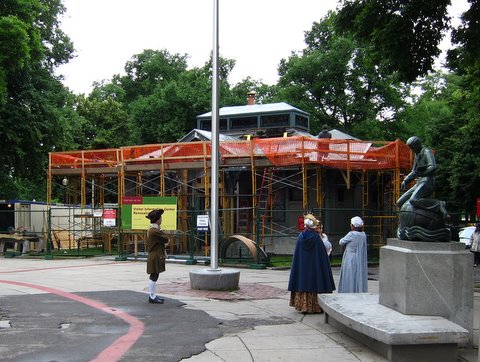
Well that's just great. Now what? There was a temporary visitor center set up somewhere else in the common, but it was in the direction of the playground that we were trying to avoid because it was too wet to play on. It wasn't worth a fuss from Luke, so we set off on our own, with our general Boston guide book and our complimentary map (which was crummy in terms of actually helping you find anything; can no one in Boston make a decent map?!), and tackled the Freedom Trail on our own. Well, with the help of the red bricks/paint (totally brilliant idea, in my professional opinion) and the occasional sign.
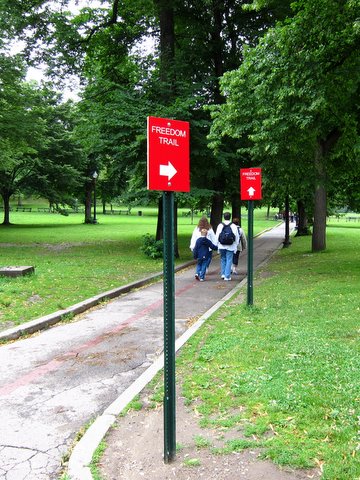
The first stop on the trail is the Massachusetts State House. Designed by Charles Bulfinch, it influenced countless other capitol designs, including Atlanta and Washington DC. According to The Rough Guide to Boston
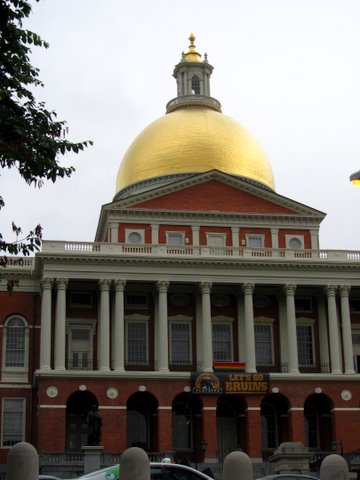
Note the "Let's Go Bruins" banner out front. The playoffs were still going on at this point, and there were similar signs everywhere, plus things sprayed on windows and famous statues wearing Bruins jerseys! (Photos of those in later posts.)
Simply turn around from the State House, and you see this amazing piece of art. While technically not a stop on the Freedom Trail, it is still worth taking a look at.
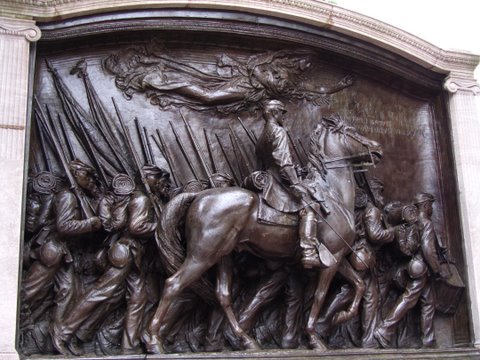
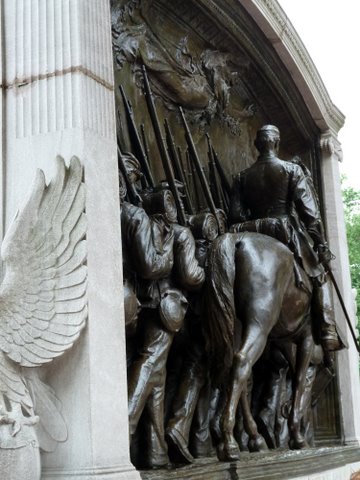
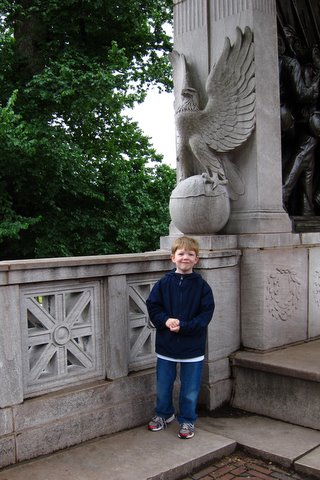
This is the 54th Massachusetts Regiment Memorial, which honors the first US Civil War All African-American volunteer company, commanded by Robert Gould Shaw. Remember the movie Glory? It was based on this regiment (and incidentally was partly filmed in my hometown). The eagle in the third photo is on the side of the memorial; I wanted to show it for the scale of the thing. Remember, Luke is just over 4 feet (1.22 m) tall. You can see part of that same eagle in the prior shot, which also shows some of the detail and depth of the, um, carving? Statue? Something in between? Anyway, it was beautifully done.
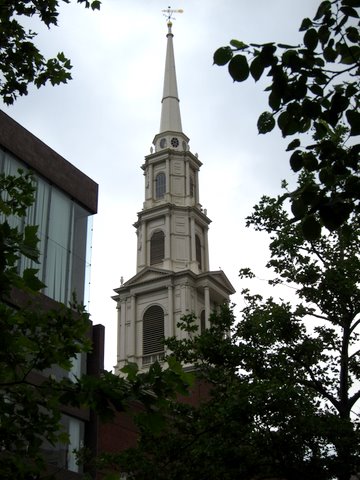
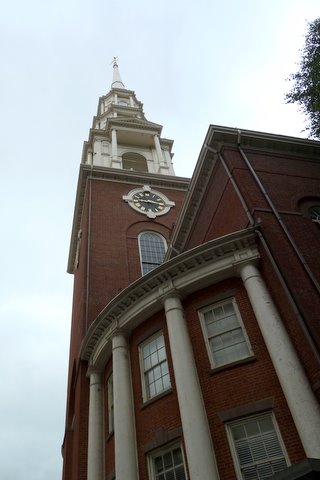
On up the street and around the corner is the Park Street Church. My favorite tidbit about it is that "My Country 'Tis of Thee" was first sung there on July 4, 1831. It is very typical of New England spire churches and reminds me a lot of the Old North Church, actually. (I wonder how many people confuse the two.)
I personally believe that Park Street Church is most famous for what it guards around the corner: the Granary Burying Grounds, where many revolutionary luminaries are interred.
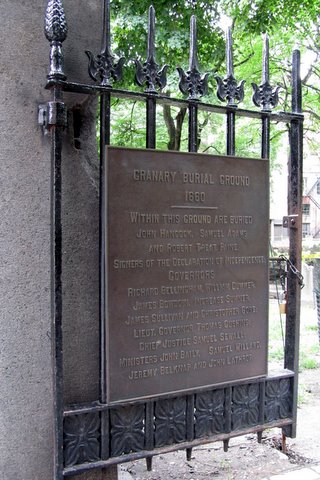
Granary Burial Ground - 1660Just to the left of the front gate is this plaque.
Within this ground are buried John Hancock, Samuel Adams and Robert Treat Paine, Signers of the Declaration of Independence; Governors Richard Bellingham, William Dummer, James Bowdoin, Increase Sumner, James Sullivan and Christopher Gore; Lieut. Governor Thomas Gushing; Chief Justice Samuel Sewall; Ministers John Baily, Samuel Willard, Jeremy Belknap and John Lathor.
Granary Gurial Ground - 1660 (opposite plaque, not pictured)
Within this ground are buried The victims of the Boston Massacre, March 5, 1770. Josiah Franklin and wife (Parents of Benjamin Franklin), Peter Faneuil, Paul Revere; and John Phillips, First Mayor of Boston.
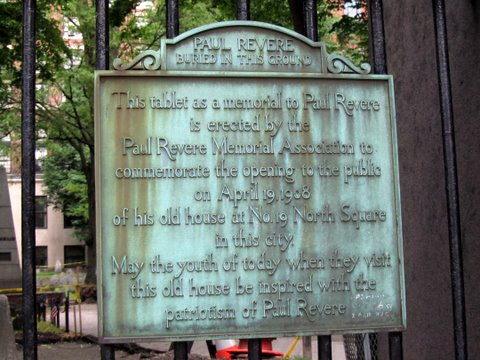
Paul Revere - Buried in this ground; This tablet as a memorial to Paul Revere is erected by the Paul Revere Memorial Association to commemorate the opening to the public on April 19, 1908, of his old house at No. 9 North Square in this city. May the youth of today when they visit this old house be inspired with the patriotism of Paul Revere.I'm sure it was put there at the time to draw attention to the fact that the house was still around. That is, of course, a well known fact today, and something we have caught much grief for *not* doing during our 2003 visit. We would be seeing the Revere House a little bit later. As you probably guessed from the title, we did not do all of the Freedom Trail in one day. We left The North End (Revere House and Old North Church) and Charlestown (USS Constitution, Bunker Hill) portions for later in the week.
They're doing a lot of maintenance inside the walls, so please forgive the caution tape and scaffolding in the photos. I think we saw virtually all of those mentioned on the gates. Here are some of the biggies.
Hancock, Revere, Franklin
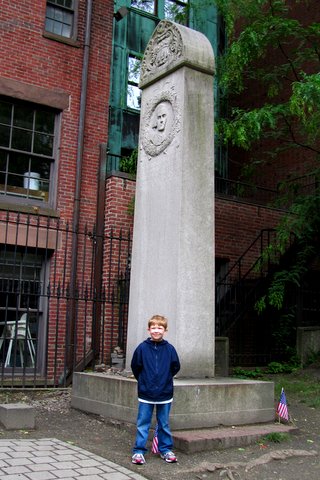
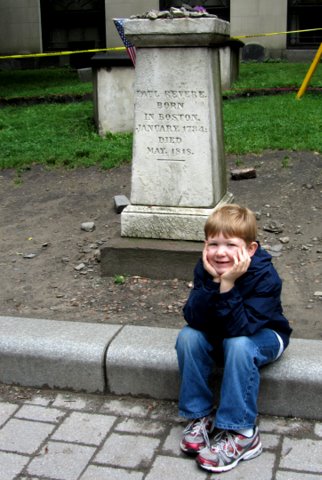
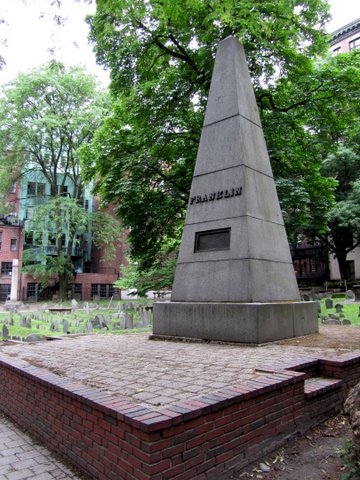
Boston Massacre, Paine, Adams
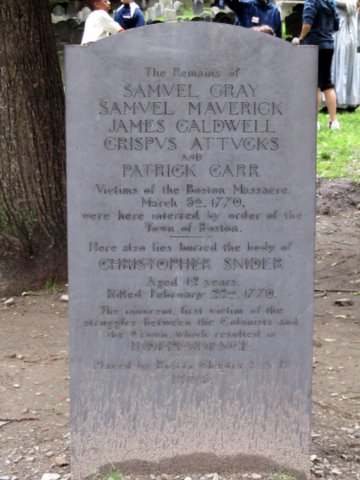
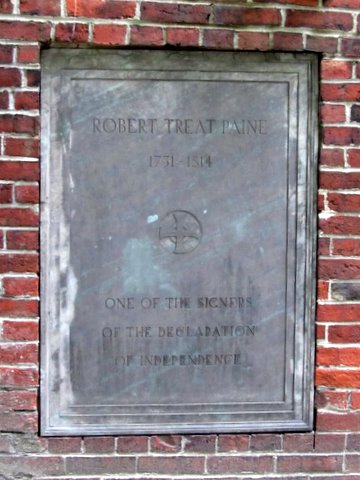
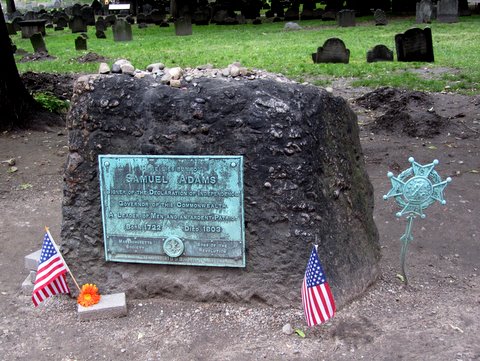
Of course, there are plenty of plain ordinary folks buried there as well.
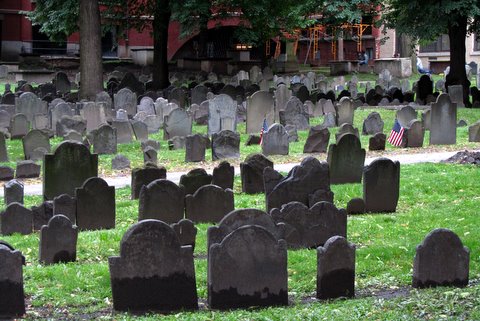
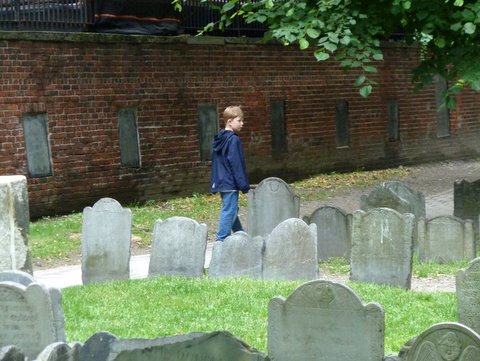
Some with terribly amusing sayings on them. Like this one:
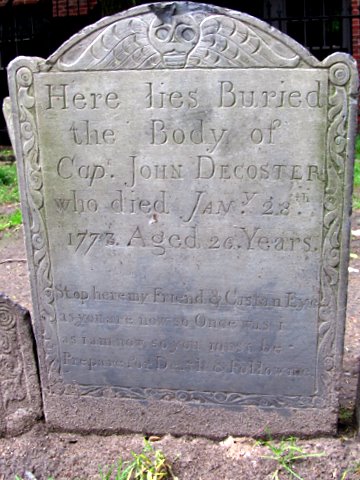
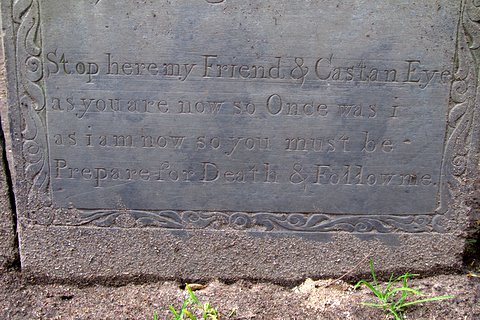
Stop here my Friend & Cast an eyeWith those words of wisdom, we hopped across the street and take a quick break. We stopped in Parker House to ooo and aah at the interior, and to sit on comfy couches in the lobby and have a snack. I believe the Parker House is the oldest continuously operating hotel in the US. It is also where DH and I stayed during our 2003 visit to Boston.
as you are now so Once was i
as i am now so you must be
prepare for Death & Follow me
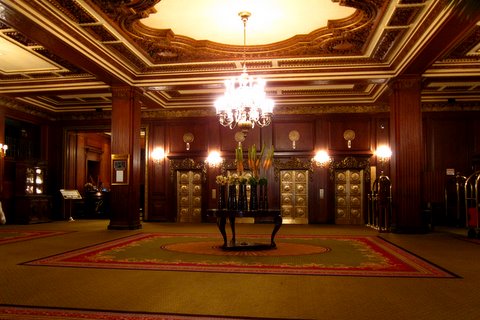
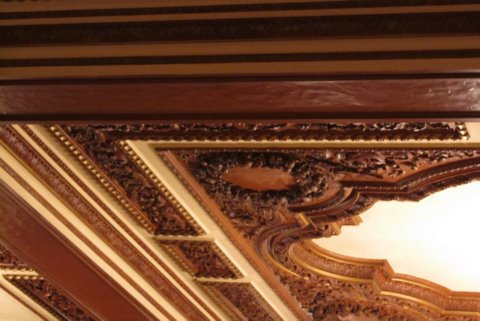
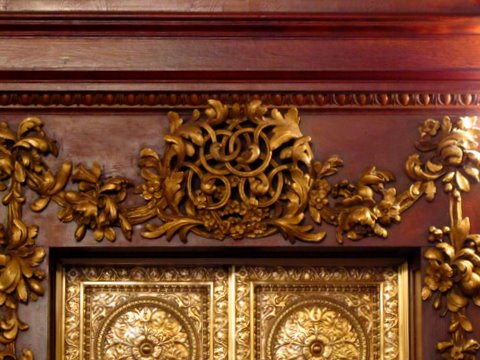
The location is phenomenal, right on (well, technically across the street from) the Freedom Trail, and as you can see even from just these few photos, it is stunningly beautiful inside. All things considered (compared to other hotels in Boston), the price isn't that bad either. But it's not a Marriott hotel, and Mom and Dad had "paid" for both of our rooms using rewards points (thank you!), so the Parker House wasn't really a choice. If you can stay there, though, I highly recommend it! But if it is out of your budget, we were also very happy with our Courtyard Copley Square location on this trip as well. [No affiliation, just very happy with our stays at both hotels.] Anyway, we would return to the Parker House a few hours later for lunch. Until then, it was time to hit the trail!
Next up was King's Chapel and Burying Ground, which we somehow managed *not* to get a long shot of in the morning (though we did later in the day; see Day 3, Part 2). The cemetery is the oldest in Boston. I had forgotten while we were there that Mary Chilton was buried there, or we would have looked for her headstone. She was the first pilgrim to set foot on Plymouth Rock.
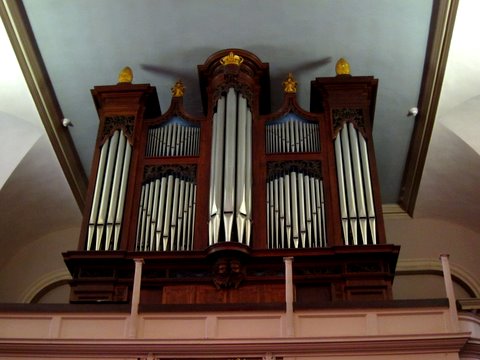
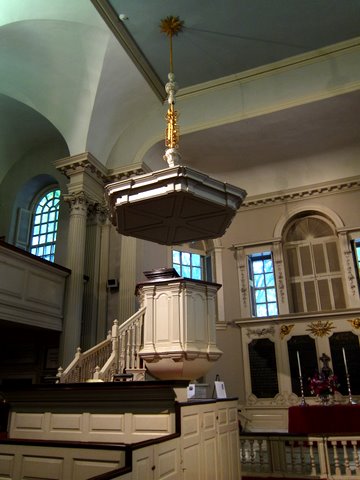
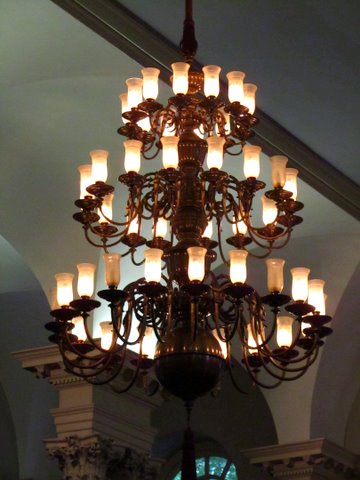
Did you know...
-King's Chapel was founded by King James II of England in 1686
-Our bell is the largest and "sweetest" ever made by Paul Revere?
-We had both Royalist and Patriot parishoners during the Revolution?
-We have the oldest pulpit in use in the United States?
-We still have an active congregation?
-We are one of the 500 most important buildings in the United States?
(copied from a sign in front of the chapel)
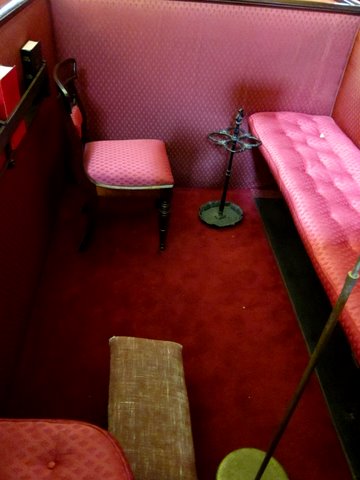
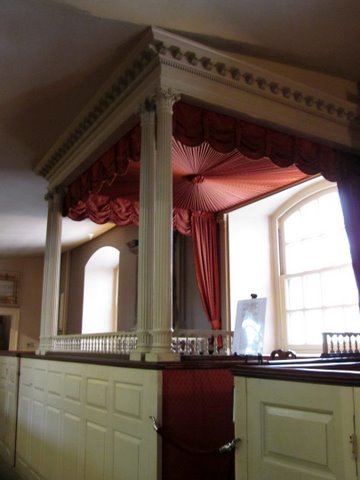
The pews were beautifully decorated, and each family was (is?) assigned their own, so they could decorate them as they chose (though all are done in this rose fabric) and have different arrangements of benches and chairs in each. The one with the canopy is the Governor's Pew, "designed for use by the Royal Governors sent as representatives of the King of England. President George Washington sat in this pew for a benefit concert following the Revolution." (From a sign inside the chapel.)
Then we headed outside to the cemetery. Nothing like a subway vent in the middle of all that history!
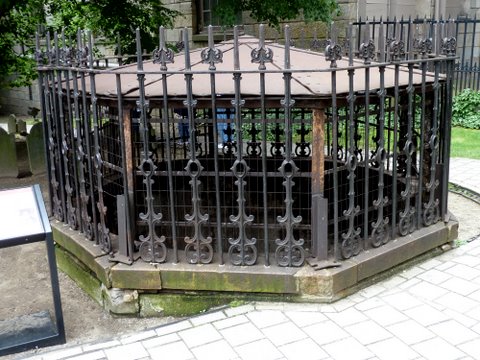
These are just some beautiful old stones. The first is for Priscilla Marinor, age 2 years 3 months, died July 19, 1690. The second is for Joseph Tapping, aged 25 years, died December 20, 1678. It just amazes me that stones *that* old look so crisp and clear and beautiful still today. The detail on Mr. Tapping's stone is gorgeous.
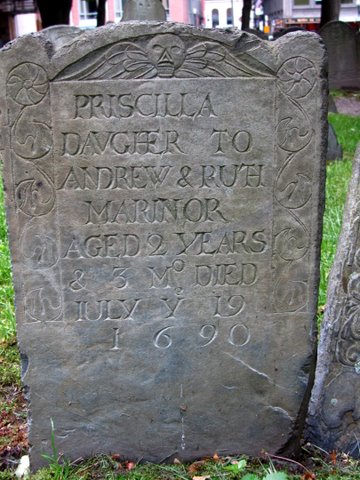
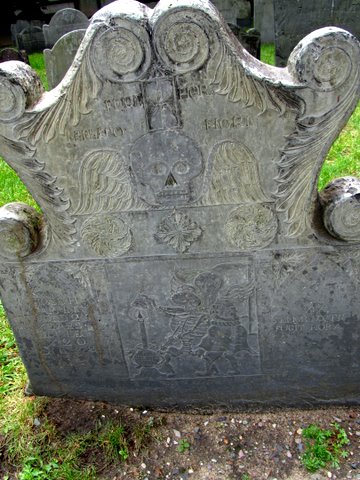
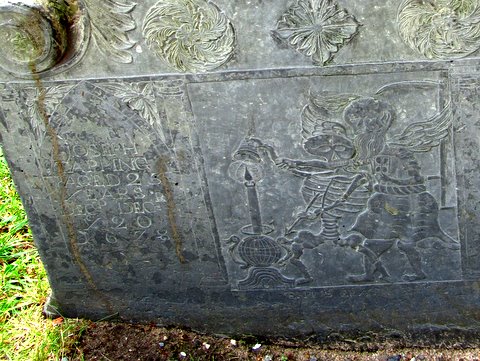
I have to say, this impressed me. So many members and generations of one family!
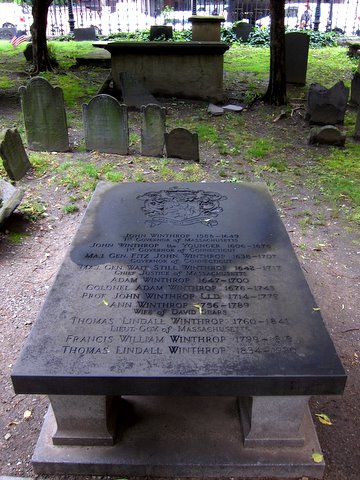
-John Winthrop 1588-1649; 1st Governor of Massachusetts
-John Winthrop the Younger 1606-1676; 1st Governor of Connecticut
-Maj. Gen. Fitz John Winthrop 1638-1707; Governor of Connecticut
-Maj. Gen. Wait Still Winthrop 1624-1717; Chief Justice of Massachusetts
-Adam Winthrop 1647-1700
-Colonel Adam Winthrop 1676-1743
-Prof. John Winthrop L.L.D. 1714-1779
-Ann Winthrop 1756-1789; Wife of David Sears
-Thomas Lindall Winthrop 1760-1841; Lieut. Gov. of Massachusetts
-Francis William Winthrop 1799-1819
-Thomas Lindall Winthrop 1834-1920
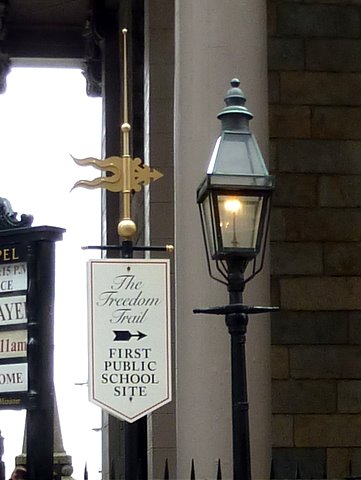
Next on the trail was the First Public School Site and Old City Hall. None of the photos of the marker for the First Public School came out clear enough to really see any details (not at this size), but we did get a photo of the sign. There were signs like this pointing to most of the Freedom Trail destinations. Note the design of the finial thing on top, with the gold banner. I'll talk more about that later.
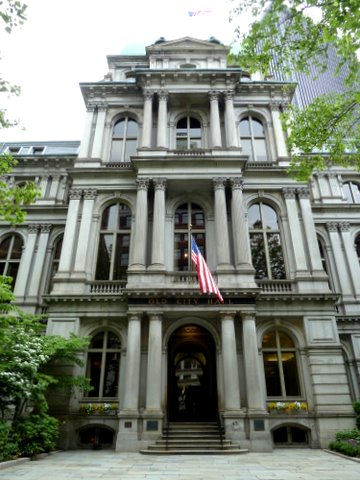
Old City Hall itself is now offices (mainly lawyers, as best I could tell) and houses a Ruth's Chris Steakhouse. I suppose Benjamin Franklin would probably have approved of repurposing the building in such a way.
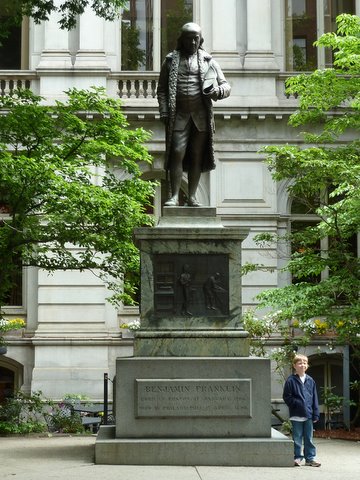
On down the street and around the corner is the Old South Meeting House.
-Built in 1729 as a Puritan meeting house, Benjamin Franklin was baptized here. Phillis Wheatly, the first African-American author, worshiped here.
-In the years leading up to the American Revolution, cononists gathered here to challenge British rule. On December 16, 1773, more than 5,000 colonists met here to protest the tax on tea, and heard Samuel Adams give the singlan that started the Boston Tea Party.
-In 1876, Bostonians fought to save this building from the wrecking ball, the first successful historic preservation effort in New England.
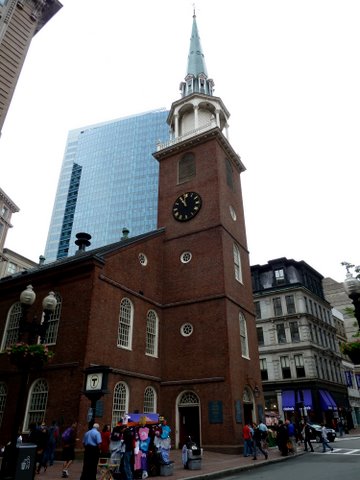

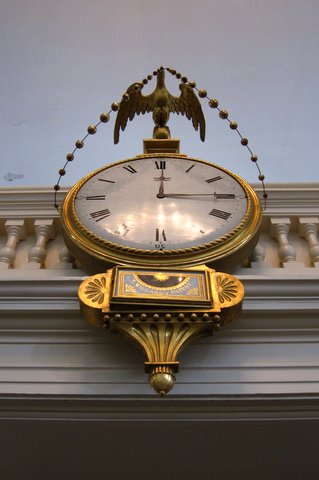
It's hard to tell if it is a meeting house or a church. It was used for both, which is why the design is such a compromise. Wider than it is long (short aisle, like a meeting house), but still with a pulpit vs just a podium (church).
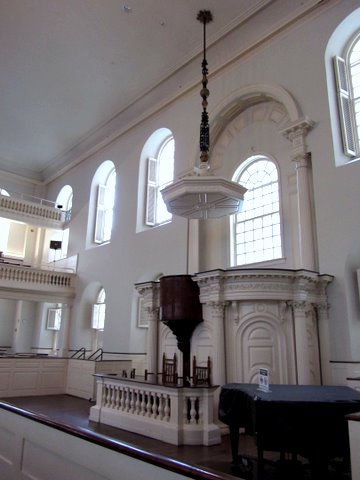
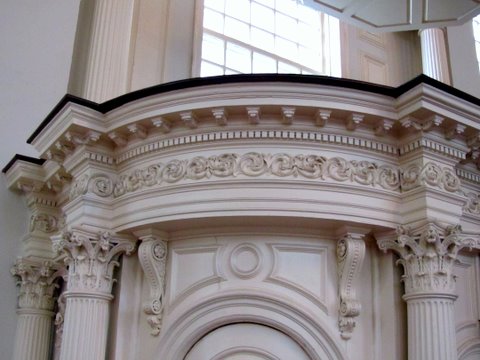
There were several interesting exhibits inside, including some tea that was allegedly from the shipment that was thrown into the harbor during the Boston Tea Party. Believe it or not, I *am* trying to limit the photos! LOL
After the Old South Meeting House, we backtracked to the Parker House for lunch, where we discovered that nothing opens for lunch before 11:30 in Boston. Sorry, we frequently eat lunch around 11, and that doesn't seem to be much of a problem in Atlanta, generally speaking. Since DH and I never ate there even though we were staying there in 2003, we decided that was a must do this time around. We started with a basketful of famous Parker House Rolls. Luke would have happily dined on those the rest of the trip! I know they're "just white dinner rolls," but they were truly amazing.
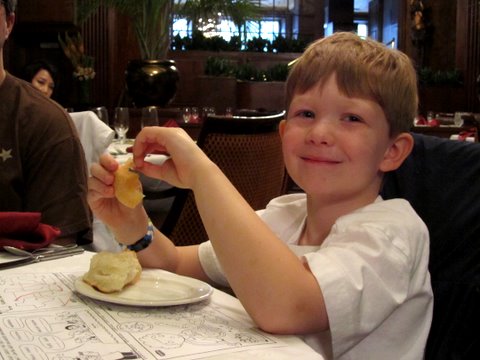
For actual food, we got a couple of bowls of Clam Chowder, which was *the* best Clam Chowder any of us have ever had, anywhere, in Boston or elsewhere. Seriously, it was awesome. Just a tureen of Clam Chowder and several baskets of rolls, and we'd have been happy campers! The rest of the meals didn't really measure up to such greatness, though it was still very good for the most part. Luke got chicken fingers and fries. Mom got the Baked Schrod, another Parker House invention. Dad and DH both got the Fish and Chips, which was very good, but Legal Seafood's was better. I decided to try the steak, which was a disappointment. First off, a medium-rare steak should have at least *some* pink in it, preferably some red. This was so overdone there was nothing but brown or gray. Maybe he thought I said medium-well? It wasn't worth waiting to send it back, but I would not recommend getting steak there. Stick with seafood!
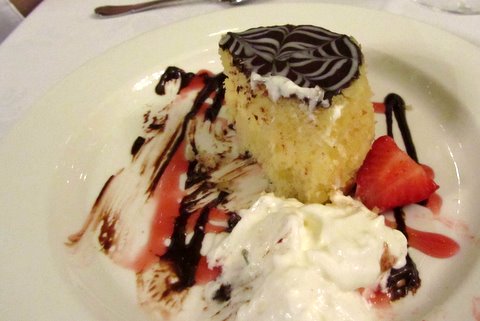
We'd done the "chowda" and the rolls and the schrod. That only left the Boston Cream Pie, another Parker House creation. Nearly forgot to take a picture! It was pretty good. Good enough that we tried it again elsewhere (and sadly, it was actually better there than at the Parker House itself, IMO). We got asked all the time after our 2003 visit if we'd eaten there, since we stayed there. At least now we can say "yes, we've had the Boston Cream Pie at the Parker House!"
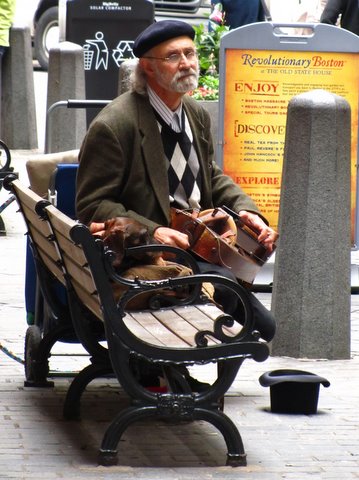
The Old State House was our first post-lunch stop on the Freedom Trail. As I mentioned in the Museum of Fine Art post, we saw a man playing a hurdy gurdy near the entrance (with his poor sad dog).
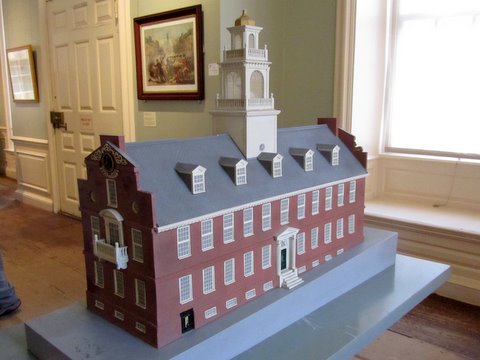
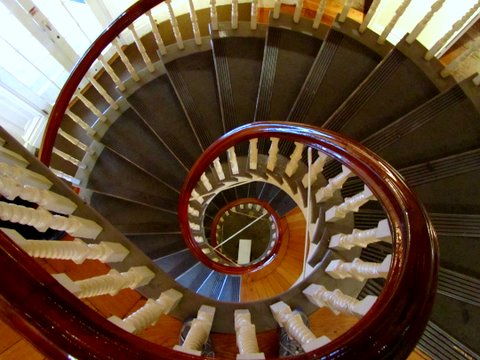
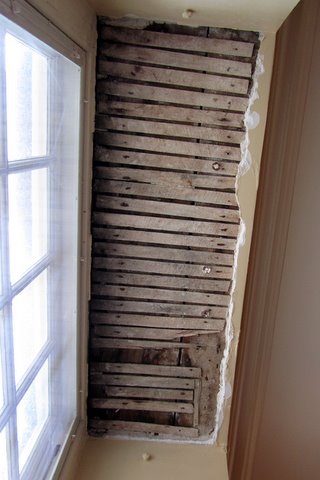
There was a sign near the window where that last photo was taken that read: "The Old State House is almost 300 years old and under constant repair. Please bear with us as we restore this area!" So hard to imagine those exposed pieces of wood are so old. There were some excellent exhibits and artifacts inside.
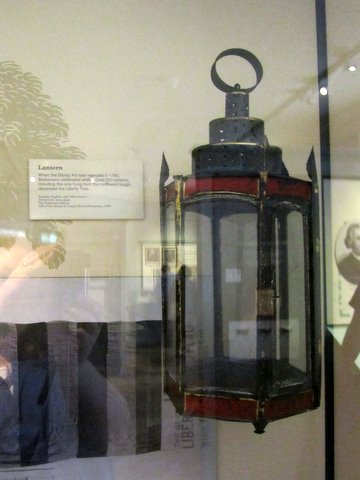
When the Stamp Act was repealed in 1766, Bostonians celebrated wildly. Over 150 lanterns, including this one hung from the northwest bough, decorated the Liberty Tree.The scrimshaw work was stunning. My mind boggles at the size of the whale that produced that center tooth. It is at least 10 inches (25 cm) tall.

"John Hancock was inaugurated in 'a suit of crimson velvet'- perhaps this luxurious outfit." I wish all of my stitching friends could have seen it in person. The detailed embroidery on the vest was absolutely beautiful.
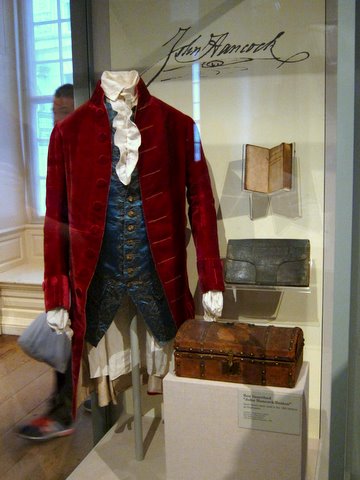
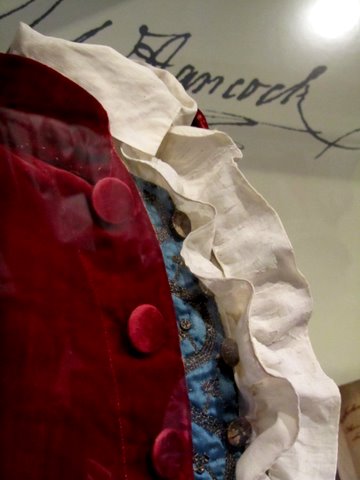
There were several rooms dedicated to things for kids to do, too, which was great!
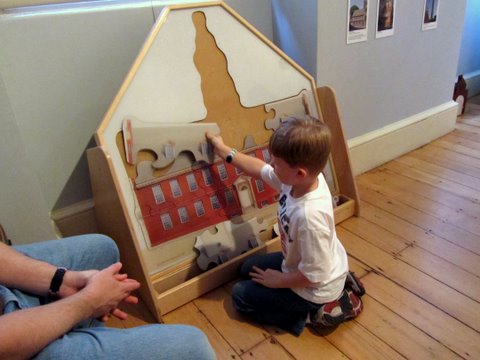
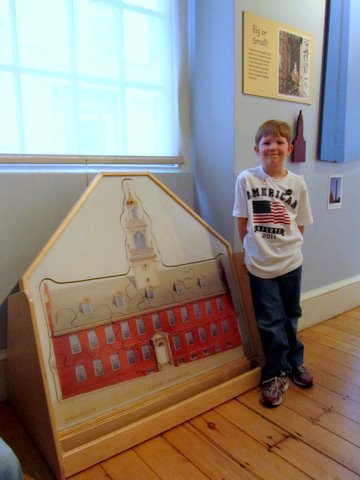
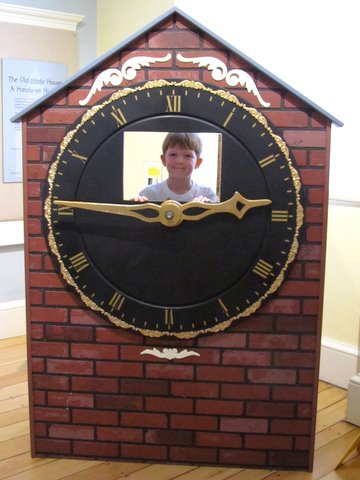
There were also several items left from when the building was used for the British representatives of the colony, before the revolution.
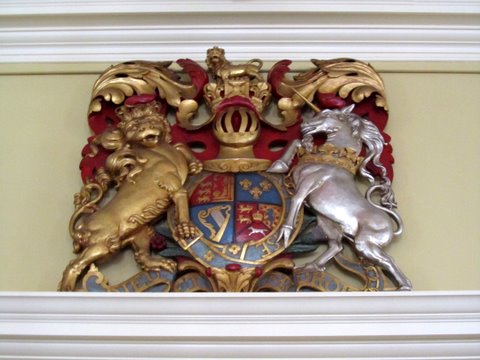
A sign in the children's area explains:
The Lion and The Unicorn - In the 1700s, the British colonial government decorated its building with a lion and unicorn, symbols of the British king. When the Declaration of Independence was first read to Bostonians here in 1776, they burned the lion and unicorn in a bonfire. Replacement animals were put on the building in 1882.
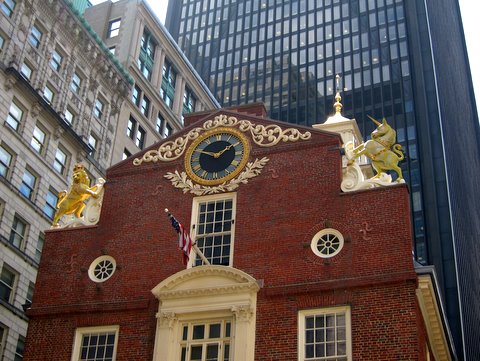
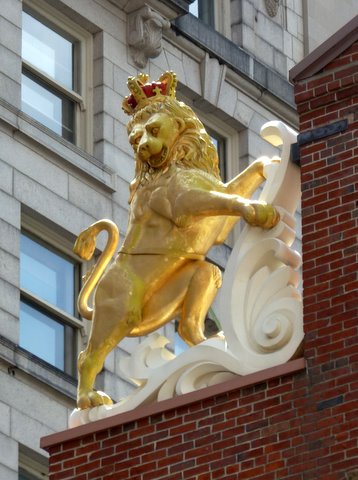
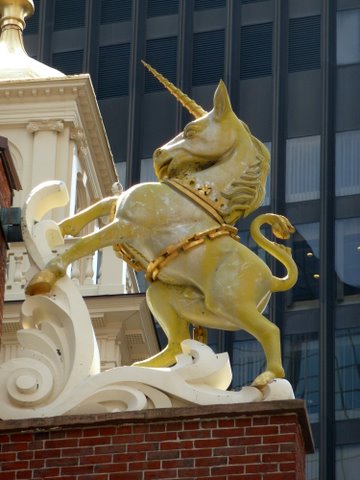
I thought the cupola was especially beautiful. Wait, what is that on top? Check out the weathervane. It wasn't until I was editing these photos to post them on my blog that I realized the Old State House weathervane is where the design at the top of the Freedom Trail signs comes from!
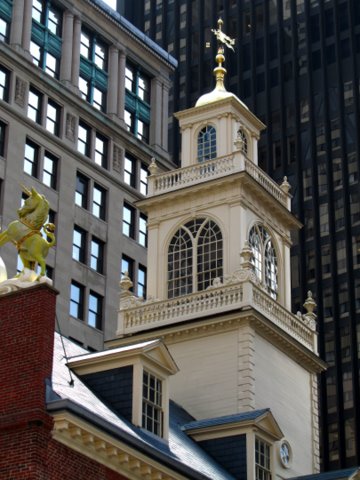
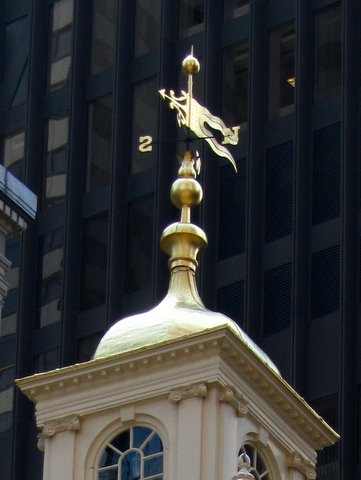
The only site remaining on Monday's portion of our Freedom Trail tour was Fanieul Hall. We had walked past it more than once already when visiting Quincy Market the previous two days. The cobblestones all around it are all torn up, with scaffolding, port-a-potties, and other various construction items surrounding it. There wasn't any sign saying it was closed, but there weren't any doors that weren't blocked off either, so we didn't try to go in.
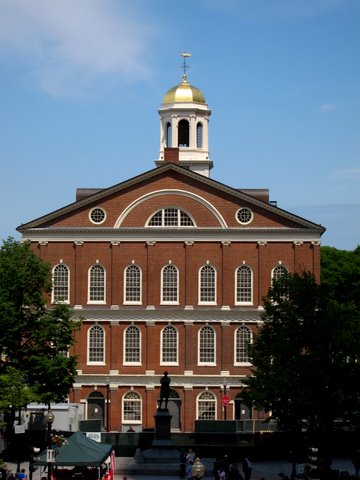
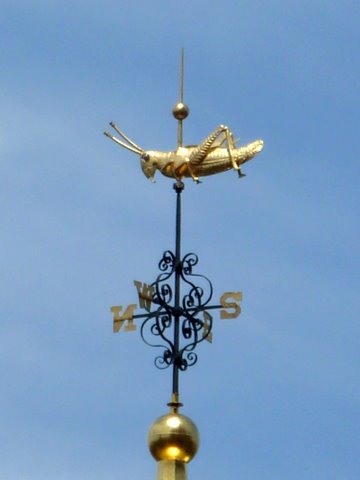
By this point, we were totally "walked out" for the day, but it was only mid-afternoon. We needed something relaxing to do, like a tour that didn't involve our feet. Perhaps an amphibious vehicle? I'd been hearing about them from Luke *nonstop* for two days; it was time. Next stop: Duck Boats! But that's another post....
Currently feeling:
No comments:
Post a Comment
My apologies for not allowing comments from Anonymous users. I was getting way too much spam. Thank you for taking the time to leave a comment!